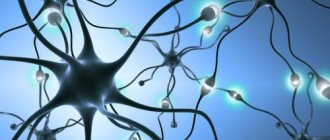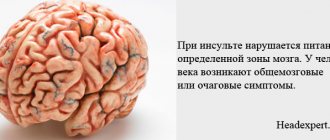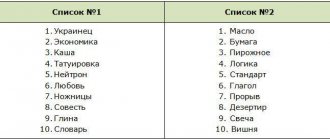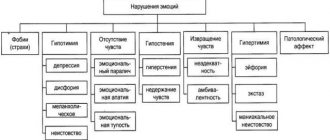In conditions of intensification of human activity and progressive growth of information, the brain is increasingly malfunctioning.
Deterioration and memory loss are the most common pathology in depressive conditions, which have taken a leading position among diseases of the 21st century.
We will talk about hypomnesia, what it is in psychology and neurology, what are the causes of the phenomenon, symptoms and signs, what is the diagnosis and treatment, in the article.
Kinds
Depending on the prevalence of certain disorders, hypomania is distinguished:
- simple or fun;
- irritable or angry, expansive.
Focusing on the personality disorders accompanying hypomania, hypomania is distinguished:
- querulant (the patient is characterized by an irresistible desire to litigate, constantly fights for “trampled” rights);
- adventuristic (the patient is prone to adventures);
- dysphoric (the patient is characterized by irritability, which is replaced by melancholy, tension, and is prone to aggressive behavior).
Focusing on the influence of hypomania on the somatopsychic sphere, an atypical variant of hypomania is also distinguished - euphoric hypochondria, in which elevated mood and unrestrained activity are aimed at combating an imaginary illness. Patients with this form of hypomania complain of vague pain and autonomic disorders.
Depending on the severity of symptoms, there are:
- obvious or pure hypomania;
- latent hypomania, in which its manifestations are expressed in an erased form.
Also distinguished is productive hypomania, which is observed with cyclothymia and is characterized by shallow disturbances of the sleep-wake cycle, acceleration of ideation processes with slight distractibility.
Characteristic
Hypermnesia is a pathological exacerbation of such properties as memorization and reproduction, as well as recognition with a strong weakening of forgetting.
The causes of this pathological disorder are still not well understood. Most often, these signs manifest themselves in two types of memory - mechanical and emotional. Usually these states are combined with a weakened semantic understanding. Therefore, in addition to good memorization, hypermnesia is characterized by symptoms such as weakening of selective reproduction and disruption of the logical sequence of reproduced events and facts. An exacerbation of involuntary mechanical memory with a deterioration in voluntary reproduction indicates the presence of memory regression.
Healthy people may also have similar symptoms. This state can occur under hypnotic influence, in dangerous life situations, or in conditions of increased responsibility. Their main difference from pathological enhancement of memorization is that these symptoms are not regressive in nature.
Such an abnormal exacerbation must be differentiated from phenomenal memory, since it is characteristic not only of healthy, but also of sick people.
Treatment
Currently, there is no specific drug treatment that could restore memory processes, since there is no proven and tested pharmacological agent.
Indirect treatment methods are mainly used, among which the following are worth noting:
- treatment of underlying mental illness;
- the use of nootropics that restore brain structures, these include nootropil, phenotropil and many others.
- stabilization of blood circulation in the main brain structures;
- psychotherapy;
- diagnosis and exclusion of traumatic situations in a person’s life, elimination of stress.
Treatment must be carried out under conditions of clinical observation; constant registration of all changes is necessary. Treatment depends on the specific features of the underlying pathology that the person suffers from. In addition to nootropics that accelerate the functioning of nerve cells, vitamins and antioxidants are prescribed
It is also important to ensure and create a favorable environment around the patient. The patient should be limited from any factors that provoke stress.
For prevention purposes
Remember that memory performance always depends on the general condition of your body. Therefore, keep an eye on it, do exercises, develop your thinking, solve problems and memorize texts, and then you can count on a very good memory.
In addition, it is necessary to avoid stressful situations and minimize possible nervous breakdowns. If you notice any changes in your mental state, or there are personal problems in your life that constantly bother you, then do not be lazy and contact a psychotherapist about them.
Together you can solve everything that bothers you before it begins to affect the state of your body, including memory.
Symptoms of mental disorders
The World Health Organization calls the main manifestations of behavioral deviation, a mental illness, disturbances in mental activity, mood or behavioral reactions that go beyond the boundaries of existing cultural and moral norms and beliefs. In other words, psychological discomfort, disturbances in activity in various areas - all these are typical signs of the described disorder.
In addition, patients suffering from mental disorders may often experience a variety of physical, emotional, cognitive, and perceptual symptoms. For example: an individual may feel unhappy or overhappy out of proportion to the events that have occurred, and there may be failures in building logical relationships.
The main symptoms of mental disorders are increased fatigue, rapid unexpected changes in mood, inadequate response to an event, spatio-temporal disorientation, vague awareness of the surrounding reality with defects in perception and violations of an adequate attitude towards one’s own state, lack of reaction, fear, confusion or the appearance of hallucinations, disturbance sleep, falling asleep and waking up, anxiety.
Often, an individual who has been exposed to stress and is characterized by an unstable mental state may develop obsessive ideas, expressed as persecution mania or various phobias. All this subsequently leads to prolonged depression, accompanied by periods of short, violent emotional outbursts aimed at developing some impossible plans.
Often, having experienced severe stress associated with violence or the loss of a close relative, a subject with unstable mental activity can make a substitution in self-identification, convincing himself that the person who experienced all this in reality no longer exists, it was replaced by a completely different person who does not has something to do with what happened. Thus, the human psyche seems to hide the subject from terrible intrusive memories. This “substitution” often has a new name. The patient may not respond to the name given at birth.
If the subject suffers from a mental disorder, then he may experience a disorder of self-awareness, which is expressed in confusion, depersonalization and derealization.
In addition, people with mental disorders are susceptible to weakened memory or its complete absence, paramnesia, and impaired thinking.
Delirium is also a frequent accompaniment of mental disorders. It can be primary (intellectual), sensory (imaginative) and affective. Primary delusion initially appears as the only sign of mental disorder. Sensual delirium manifests itself in a violation of not only rational knowledge, but also sensory one. Affective delusions always occur together with emotional deviations and are characterized by imagery. They also distinguish overvalued ideas, which mainly appear as a result of real-life circumstances, but subsequently occupy a meaning that does not correspond to their place in consciousness.
Making the correct diagnosis
First of all, the doctor interviews the patient, who must describe his condition and its difference from when, in his opinion, there were no changes in memory.
Also, various tests are always used in order to more reliably detect the objective presence of violations. Tests with pictograms, memorizing text, as well as the “10 words method” proposed by the Soviet psychologist Alexander Luria are common.
The following studies are prescribed:
- the neural activity of the brain is studied using EEG;
- carried out (computed tomography) and MRI (magnetic resonance imaging);
- Ultrasound of organs;
- electrocardiogram.
Urine and blood tests are also prescribed to verify the absence or, conversely, the presence of somatic diseases, which could lead to a failure.
It is extremely important for the doctor to make sure that the patient has hypomnesia and not some other disease, especially of a mental nature. For example, depression and neurosis have the same symptoms, but their treatment has nothing to do with the treatment of hypomnesia.
Symptoms
Manifestations of paramnesia include many different qualitative distortions of memory. Depending on their specificity, several types of this disorder are distinguished. Paramnesias include:
- pseudoreminiscence;
- confabulation;
- cryptomnesia;
- phantasm;
- reduplicating paramnesia;
- false recognition.
The main symptom of pseudoreminiscence is that a person passes off past events as present. He describes facts from ordinary life that actually happened, but at a different time, and do not relate to the current situation. Pseudoreminiscence is characteristic of dementia, Korsakoff's syndrome and other conditions accompanied by hypomnesia.
The main manifestation of confabulation is the transformation of real memories by introducing fictitious elements (objects, actions) into them. Types of confabulations:
- replacement - filling gaps in memory with real events from other time periods;
- ecmnestic – transfer of early childhood events into recent memories;
- fantastic - memories of fantastic events in which the patient participated in his opinion;
- delusional – distortion of memories by introducing delusional episodes into them;
- hallucinatory – supplementing descriptions of events with fragments of visual and auditory hallucinations.
A sign of cryptomnesia is the perception of information read, heard or seen as actually experienced. As a rule, cryptomnesia is combined with different types of amnesia. At the same time, patients are poorly oriented in time and space, get tired quickly, but retain acquired knowledge and skills well. Cryptomnesia occurs with senile psychoses, brain damage and cerebral atherosclerosis.
Phantasms are memories in which hallucinatory events are embedded. They occur in people with multiple personality disorder and schizophrenia. Fantasies are distinguished by their crudeness and absurdity, and in some cases, by an intriguing plot.
Reduplicative amnesia (dual perception) is expressed in the repetition of memories: it seems to a person that the same events are happening several times. He experiences a feeling of incomplete déjà vu.
False recognition occurs when people, objects, and places are mistakenly identified. In severe cases, a person cannot recognize loved ones or his own reflection in the mirror.
Diagnostics
Systematic loss of memory episodes, or a violation of one of the memory functions, gives reason to consult a specialist - a neurologist, psychiatrist or psychotherapist:
- Collection of complaints and anamnesis: when and where, since what time signs of memory loss appeared, were there any diseases or causes that contributed to the occurrence of hypomnesia.
- Tests for diagnosis:
- 10-word method - the doctor slowly reads 10 simple words that are not related to each other, then asks the patient to repeat them and notes the words that the patient reproduced.
Then the doctor repeats them again, the patient answers, then the patient must make 4-6 attempts to reproduce these words independently, the last one after an hour;
pictogram method - how the patient remembers information more easily: by ear or by sight. The patient remembers words and phrases and draws something on paper that will help him reproduce them in the future. However, it is not permitted to make alphabetic or numeric entries;
- 10-word method - the doctor slowly reads 10 simple words that are not related to each other, then asks the patient to repeat them and notes the words that the patient reproduced.
- methods of working with text – study of mechanical and logical memory. The patient is asked to repeat the light text read. Mechanical memory is assessed by the accuracy of text reproduction, and logical memory by the identity of meaning in the retelling. Rating on a 4-point scale and as a percentage of information reproduced, the norm is 80%. With hypomnesia, mechanical memory suffers.
- Additional research methods to identify concomitant diseases and causative factors of memory loss:
- magnetic resonance imaging (MRI) - analysis of electromagnetic waves absorbed and reflected from tissues allows us to identify features of the anatomical structure of the vessels of the head and the pathology of brain structures. MRI visualizes soft tissues with diffuse and focal lesions of brain structures, but does not show the bones of the skull;
- computed tomography (CT) - analysis of cross sections of the brain allows you to study the chemical structure of tissues and their X-ray density, which usually changes in diseases.
- Laboratory tests are prescribed to identify severe somatic diseases, infections, vascular disorders: standard general analysis and biochemical blood test (increased AST, ALT, bilirubin level, changes in acid-base balance).
- Electroencephalography is the analysis of a graphical representation of fluctuations in the electrical potentials of the brain in order to identify changes in its functions.
In some cases, to obtain a complete picture of the disease, MRI and CT should be performed simultaneously.
How to treat?
The treatment regimen is built on the basis of test results, the results of the examination completed and the established diagnosis. All basic therapy comes down to the possible elimination of the primary disease and most often requires a hospital stay.
In the most common version, abnormally heightened memory accompanies manic syndrome. In this case, it is necessary to solve 3 main tasks: to stop the root cause, stabilize the patient’s condition and prevent possible relapses.
Relief is carried out using psychotropic tranquilizers based on lithium (lithium oxybutyrate). For a faster effect, the drug is sometimes combined with antipsychotics. And in a particularly acute stage of manic psychosis, Finlepsin is additionally prescribed.
Antidepressants with a sedative effect help stabilize the mental state. Therapy of the depressive phase often involves the appointment of Tsipramil, Transamine, Nuredal or Fluoxetine.
Prevention of relapses takes place on an outpatient basis and consists of adjusting the dosages of prescribed medications. To a large extent, its effectiveness depends on strict adherence to the dosage schedule without any independent cessation of treatment.
If hypermnesia was provoked by drug or alcohol intoxication, a course of detoxification procedures is often sufficient to return the psyche to normal. When abnormal memory aggravation occurs during treatment with psychotropics, the dosage of the drugs is revised, and the natural process of forgetting begins to function as before.
general information
Memory impairment in psychology is a type of cognitive impairment, the symptoms of which include complaints of decreased memory or mental performance. Regarding memory problems, deviations are reflected in the storage, retrieval and establishment of functional connections between information about events and objects.
Memory is closely related to:
- speech;
- thinking;
- perception;
- emotions;
- voluntary actions.
Memory is a mental process that involves recording, storing, and retrieving information. The quality of memorization is determined by a person’s attention to the object of recording. The opposite of the act of remembering is forgetting, which is an important condition for remembering, since it relieves the central nervous system, making room for new connections.
Memory is determined by the work of the entire brain, but first of all, it is a biological phenomenon caused by the activity of the senses. Human memory is an infinitely more complex mechanism - it is a function of the brain, the neural activity of which allows memories to be filtered, stored and destroyed.
Memory impairments are so characteristic that they can serve as the most important diagnostic criterion in recognizing some acute and chronic mental illnesses. Some deviations in memorizing, storing and reproducing information may indicate the presence of a procedural mental illness and various types of dementia (dementia).
The process of recovering memories and memory in general is very complex. Treatment should be based on eliminating the cause of amnesia. To get rid of the symptom, therapy is carried out for the primary disease. During the course of the main treatment, drugs that have a positive effect on brain activity may be prescribed.
These medications include:
- B vitamins;
- nootropic substances;
- antioxidants;
- neuroprotectors.
Memory work is determined by the activity of nerve cells - neurons. To prevent memory impairment, it is also recommended to regularly strengthen neural connections by learning new material and using it, for example, by memorizing poems.
Memorization can also be improved if you gradually increase the complexity of the material being learned and repeat it at intervals.
What is the danger of the disease
“Hypomania” is a psychological concept meaning hyperactivity. Some believe that this is a real gift, because a person has a lot of energy to work and carry out many processes. But the problem is that a patient suffering from this disease cannot correctly assess the situation and often overestimates his abilities. As a result, he loses strength, his state becomes apathetic, and all this leads to the following consequences:
- loss of energy due to lack of sleep, which leads to decreased memory, lack of concentration, and the appearance of “fog” in the head;
- excessive food consumption and a general lack of regime lead to an exacerbation of diseases of the gastrointestinal tract - a person begins to gain weight or lose weight;
- the tendency to consume alcohol and the craving for excessive wastefulness sooner or later entail financial difficulties, and the patient begins to become depressed, which further aggravates the situation, since there is no longer enough strength or desire to correct it;
- after the period of the described emotional upsurge comes a period of falling mood, which can last for a very long time, sometimes for years;
- Inappropriate behavior of the patient leads to problems at work, aggravation of relationships with friends and relatives.
Most often, people in creative professions suffer from such symptoms. After a period of complete inspiration, albeit unnatural, they turn to depression, begin to drink too much, get sick and lose the desire to create. And an attempt to regain their former high often leads them to the use of drugs. In a vain attempt to artificially create a rosy picture of the world around them, they become drug addicts and sink even deeper into the quagmire of psychological problems.
Types of disorder
Experts distinguish several forms of hyperthymesia:
- General, or diffuse - this type of hypermnesia is characteristic of a depressive state, the manic phase of depressive psychoses, in the initial stages of intoxication caused by alcohol or drugs. Also, this type of memory disorder accompanies delusional (paraphrenic) syndromes.
- Partial, or elective, is hypermnesia that accompanies paranoia, mental retardation, epilepsy, schizophrenia, and hydrocephalus. With this form of pathology, memory is sharpened for exceptional events or facts and strictly during certain periods of the illness.
- Reactive or psychogenic hypermnesia is a condition in psychology when memory exacerbation occurs in response to traumatic events.
These are the main types of pathology, but there are other particular clinical manifestations. Problems in classification, diagnosis and treatment are caused by uncertainty about the physical, anatomical and psychological causes of hypermnesia, which can be episodic or persistent.
General information
Mood disorders as early as the 5th century BC. e. were divided into melancholy and mania (these terms were used by Hippocrates in his writings).
After 1896, all mood disorders, according to the concept of E. Kraepelin, began to be classified as manic-depressive psychosis (MDP). The concept of MDP, covering both manic-depressive and depressive mood disorders, remained mainstream throughout the 20th century.
In the 60s of the XX century. The heterogeneity of MDP was noted in the studies of Angst, Perris and Vinokur, who distinguished unipolar and bipolar forms of this disorder.
In 1976, Danner identified 2 types of TIR:
- Type I, in which alternating episodes of depression and mania (severely elevated mood causing a serious impairment of functional status);
- Type II, in which depression alternates only with hypomania (elevations in mood that do not cause serious disturbances).
According to the ICD-10, adopted in 1990, there are 3 degrees of severity of mania (hypomania, mania without psychotic symptoms and mania with psychotic symptoms).
A mood disorder is considered an episode of disorder if it lasts about 1 week in the case of mania of any severity.
In hypomanic states, most patients consider themselves healthy and do not consult a doctor (they can be observed in connection with somatic diseases by general medical practitioners).
Due to the fact that MDP remains unrecognized for a long time in many patients, and in hypomanic disorder the diagnosis of “recurrent depression with short periods of elevated mood” is often made, there are no accurate data on the prevalence of hypomania.
Terms and concepts
Throughout life, each of us forgets a huge amount of information, and this is normal. But some people's memory retains everything that has ever happened in their life. This feature of higher nervous activity was discovered by scientists in 2006 and was called “hypermnesia” (Latin hypermnesia, comes from the words “super” and “memory”). This property of memory is characterized by an intensification of memorization, recognition and reproduction in the complete absence of forgetting.
In the medical and psychological literature, synonyms for hypermnesia are hyperthymesia and hyperthymestic syndrome. The statuses of these designations are blurred, and the reasons for this condition even today raise more questions than answers. According to some reports, the existence of about 50 people with this syndrome has been identified and confirmed in the world. Hypermnesia, hypomnesia (weakening of memory functions) and amnesia (partial or complete absence of memory) are all pathologies of the memory apparatus, in which the functions of memorizing and storing information are disrupted.
Causes of memory impairment
There are a huge number of factors that provoke disorders of cognitive functions of the psyche. For example, human memory impairments can be triggered by the presence of asthenic syndrome, manifested in rapid fatigue, exhaustion of the body, and also arise due to the individual’s high anxiety, traumatic brain injuries, age-related changes, depression, alcoholism, intoxication, and micronutrient deficiency.
Memory impairment in children can be due to congenital mental underdevelopment or an acquired condition, which is usually expressed in the deterioration of the immediate processes of memorizing and reproducing received information (hypomnesia) or in the loss of certain moments from memory (amnesia).
Amnesia in young representatives of society is often a consequence of trauma, the presence of mental illness, or severe poisoning. Partial memory defects in children are most often observed as a result of the influence of the following factors in combination: an unfavorable psychological microclimate in family relationships or in a children's group, frequent asthenic conditions, including those caused by persistent acute respiratory infections, and hypovitaminosis.
Nature has arranged it this way that from the moment of birth, infants’ memory is constantly developing and, therefore, is vulnerable to unfavorable environmental factors. Among such unfavorable factors are: difficult pregnancy and difficult childbirth, birth injuries to the child, long-term chronic illnesses, lack of competent stimulation of memory formation, and an excessive load on the children’s nervous system associated with an excessive amount of information.
In addition, memory impairment in children can also occur after suffering from somatic diseases during the recovery process.
In adults, this disorder can occur due to constant exposure to stress factors, the presence of various ailments of the nervous system (for example, encephalitis or Parkinson's disease), neuroses, drug addiction and alcohol abuse, mental illness, depression, schizophrenia.
In addition, somatic diseases are considered to be an equally important factor that strongly affects the ability to remember, in which there is damage to the vessels supplying the brain, which leads to pathologies of cerebral circulation. Such ailments include: hypertension, diabetes mellitus, vascular atherosclerosis, pathologies of the functioning of the thyroid gland.
Also, impairment of short-term memory can often be directly related to a deficiency or failure to absorb certain vitamins.
In people who have passed the age of sixty, almost all cognitive disorders are provoked by a deterioration in cerebral circulation, which occurs as a result of age-related changes in the blood vessels. In addition, metabolic processes change with the number of years lived. This disorder can also be caused by Alzheimer's disease.
Basically, if the natural aging process is not burdened by any accompanying ailments, then the decline in the functioning of the cognitive mental process occurs very slowly. At first, it becomes more difficult to remember events that happened a long time ago; gradually, as an individual ages, he cannot remember events that happened quite recently.
Impaired memory and attention can also occur due to iodine deficiency in the body. When the thyroid gland is underactive, individuals experience excess weight, lethargy, depression, irritability, and muscle swelling. To avoid the problems described, you must constantly monitor your diet and eat as many iodine-rich foods as possible, for example, seafood, hard cheese, and nuts.
Not in all cases, individuals' forgetfulness should be equated with memory dysfunction. Often the subject consciously seeks to forget difficult life moments, unpleasant, and often tragic events. In this case, forgetfulness plays the role of a defense mechanism. When an individual represses unpleasant facts from memory - this is called repression; when he is sure that traumatic events did not occur at all - this is called denial; displacing negative emotions on another object is called replacement.
Causes
Causes of hypomnesia:
- Vascular – weakening of oxygen supply to the brain due to atherosclerosis.
- Mechanical – external force on the brain, head injuries.
- Toxicological – decreased brain function due to chronic alcohol consumption, smoking and inhalation of volatile substances, fumes of certain medications.
- Age-related – senile dementia, decreased intellectual abilities acquired during life.
- Organic factor – neoplasms of oncological and parasitic etiology or bacteriological origin.
- Genetic factor – hereditary diseases, mental retardation.
- Psychological factor – chronic depressive states, stress, overwork, apathy.
- Nutritional factor - an imbalance between the quality and quantity of substances consumed by the body, a lack of fat-soluble vitamins, phosphorus, magnesium, zinc, etc.
- Infections of viral or bacterial origin, with febrile conditions and damage to the membranes and tissues of the brain.
- Mental factor - mental abnormalities or neurological disorders, epilepsy, vegetative-vascular dystonia.
- Concomitant diseases - hypertension, liver cirrhosis, diabetes mellitus, renal failure.
Classification
There are different types of disorders of this mental function. First of all, these are two large groups, which are divided into many small ones: memory disorders include dysmnesia (quantitative) and paramnesia (qualitative).
Quantitative memory impairment (dysmnesia)
Hypermnesia
A condition in which memories of many events from the past are pathologically accurately preserved to the smallest detail. And everything would be fine, but they have no meaning for the present. In normal development this is usually forgotten. Why is that bad? Firstly, unnecessary old memories clog up space in the memory storage and thereby prevent new ones from gaining a foothold. Therefore, with hypermnesia, current information is almost not recorded. Secondly, the logical sequence of events is disrupted.
Example. After a holiday at sea, it is not the pleasant moments that are remembered (the beach, bright tropical vegetation, new acquaintances, delicious food, etc.), but such minor nuances as the interior of the hotel room, the clothes of the service staff, the particulars of the flight, etc. When In various pathologies, hypermnesia takes the form of partial, i.e. selective. In particular, oligophrenics are excellent at remembering sequences of numbers, and they do it without any purpose.
Hypomnesia (holey, slotted, perforated memory)
A condition in which a person only partially recalls information from the past
As a rule, he is able to remember only what is constantly repeated in his life and is personally important to him. But historical dates, news, old acquaintances, terms, names - all this is consigned to oblivion
Example. A person accurately reproduces a multi-digit phone unlock code, because
does this every day and it is important to him. But he won’t be able to say in what year serfdom was abolished or what the name of his first teacher was.
Amnesia
A condition characterized by the inability to remember a certain period of time. Depending on how long the period occurs, several more subtypes are distinguished within this disorder:
- retrograde - events prior to some traumatic factor (severe stress, traumatic brain injury, etc.) are forgotten; they can span minutes and years;
- anterograde - there are no memories of what happened immediately after the traumatic factor;
- congrade - loss of what occurs during a protracted illness accompanied by impaired consciousness;
- anterograde (complete, total) - everything that is associated with a protracted, serious illness and traumatic factor is forgotten, as well as events that occurred before this.
Depending on which function is impaired, this disorder is divided into several subtypes:
- fixation - the inability to remember and reproduce information leads to disorientation (a person does not understand where he is, who surrounds him, how he should behave);
- anekphoria - the inability to consciously, voluntarily remember without prompting.
Classification depending on the flow:
- progressive - an increasing disorder explained by Ribot's law (see below);
- stationary - persistent memory loss;
- regressive - gradual restoration of forgotten events;
- retarded (delayed) - events are not restored in chronological order; some period may be omitted for a long time, and then remembered many years later.
Depending on the object, amnesia occurs:
- affectogenic (catathymic) - occurs as a result of a psychotraumatic situation, after a strong shock, all the events that accompany a nervous breakdown are forgotten;
- hysterical - the result of a psychopathic syndrome, some individual moments are forgotten;
- scotomization - conscious forgetting of events that cause pain or traumatize;
- palimpsests (alcoholic) - loss of what happened during intoxication.
Related article: Amnesia
Clinical picture
Depends on the severity and forms of manifestation. The main symptom is a loss or decrease in one of the memory functions , while the remaining functions of storing and reproducing information are not affected.
The lost function is partially restored over time: first he remembered - then he reproduced it, or vice versa, he gave out information, and later forgot that he had already talked about it.
In adolescents, the disease manifests itself as “clip thinking” – the inability to analyze and reproduce school material. A teenager's constant presence on social networks and watching short videos leads to memory deterioration.
General signs
Hypomnesia is characterized by:
- Decreased ability to remember new events.
- Replacement of logical memory with mechanical memory - semantic perception or identification of the essence of the object being studied - cramming.
- Difficulties in building a chain of chronological events, loss of events from memory.
- Loss of sense of time or disorientation in it.
Differential diagnosis
Anekphoria is a memory impairment that often accompanies hypomnesia, the inability to remember any background information at the moment without someone’s help.
Clinically manifested by awareness of memory impairment and the inability to independently remember names and dates. Restored after someone reminds you of the date or name.
Transient global amnesia (TGA) is a syndrome of sudden memory loss with the inability to remember new information and loss of memory of events that happened the day before. TGA attacks are single, lasting from 20 minutes to 24 hours.
Paramnesia is the inability to distinguish between fiction and reality; events that took place in reality are interspersed with fiction.
Depression is a mental disorder, low mood or loss of the ability to experience pleasure (anhedonia).
Treatment
Treatment and correction of memory disorders entirely depend on the cause of their occurrence. Therefore, first of all, the provoking factor is identified and all measures are taken to eliminate it. Usually a therapeutic course is prescribed. If complete recovery occurs, all gaps are restored. If we are talking about an incurable disease, the patient with these problems will have to live until the end of his days.
Psychiatry treats serious disorders that cannot be corrected without medication. Most often, such patients are prescribed the following drugs:
- nootropics (Piracetam, Lucetam, Nootropil);
- energy metabolism substrates (glutamic acid);
- herbal remedies (Bilobil, Eleutherococcus).
Nootropics
These drugs are available without a prescription, so they are often used in self-medication to increase concentration and performance. However, experts warn that this can have dangerous health consequences.
In psychology, correction is carried out using:
- individual and collective trainings;
- exercises to train attention, thinking and memory;
- various mnemonics;
- creating meaningful phrases from the first letters;
- rhyming;
- Cicero's method (based on spatial imagination);
- Aivazovsky method (based on visual memory);
- psychological and pedagogical correctional influence.
Pathopsychology achieves good results in correction. This is a practical branch of clinical psychology that studies any pathology in comparison with the norm. By constantly returning the patient to the starting point of memories, they manage to partially restore the gaps.
Recommendations for people with memory impairment:
- Lead an active lifestyle and play sports.
- Spend more time in the fresh air (to improve cerebral circulation).
- Be intellectually active: read books, follow the news, solve crosswords, knit, play chess.
- Communicate with people as much as possible, make new acquaintances.
- Maintain a daily routine. Get enough sleep.
- Avoid stress, overwork, excessive loads.
- Maintain a balanced diet and drinking regimen.
Memory is the most important component of the life of any person. The slightest violations in its work are fraught with serious complications. It can be constantly trained and improved with the help of mnemonics and special exercises, without waiting for age-related problems to arise. But most often people forget about this, which sooner or later leads to various kinds of disorders that cannot always be corrected and treated.
https://youtube.com/watch?v=yj2A57269nQ
Prognosis and prevention
If you have an unhealthy lifestyle, drinking alcohol, smoking, or being in stressful conditions, the prognosis is unfavorable. In other cases, memory function may be restored.
It is necessary to monitor the general psychological state, not withdraw into oneself, try to talk out the problem, differentiate between work and rest time, maintain a balanced diet, play sports and perform spa treatments. Improve family relationships and spend leisure time together.
Aggressive influence of the external environment can lead not only to physical, but also to psychological impotence. Decreased memory is the first harbinger of problems “within oneself.” In this article, we tried to explain the causes of hypomnesia and give treatment recommendations for memory impairment.
Asthenic syndrome, what is it?
People suffering from asthenic syndrome constantly feel exhausted, painful and incapable of activity. Some persistently feel weakness (hyposthenic type), others begin to feel it after performing any manipulations, sometimes even the most basic ones. Such lethargy is manifested by loss of ability to work, disturbance of attention and inhibition of mental activity.
Asthenic syndrome, what is it? Often individuals suffering from this disorder cannot concentrate, are immersed in themselves, and perform intellectual operations with particular difficulty. With this disease, short-term memory is predominantly impaired, manifested in difficulty remembering recent moments and actions.
If asthenic neurotic syndrome accompanies schizophrenia, then symptoms such as emptiness in the head, wretchedness of intellectual activity and associative series appear.
With pathologies of the brain, asthenic weakness is manifested by increased drowsiness and a desire to constantly remain in a lying position.
The somatogenic origin of the described disease is found in various autonomic disorders. With tachycardia and neurasthenia, hot flashes and increased sweating are observed.
Asthenic syndrome after influenza and other infectious diseases is often manifested by tremors and a feeling of cold. Frequent clinical manifestations of asthenic conditions caused by cardiovascular diseases are variability in blood pressure and rapid heartbeat. In this case, asthenia is often characterized by a rapid pulse and low blood pressure.
In asthenics, even the oculocardial reflex and eye pressure differ from the norm. Studies have shown that individuals suffering from asthenic syndrome experience an increase in heart rate when pressing on the eyeball. The norm is a slow heartbeat. Therefore, to diagnose the described disease, the Aschner-Danyini test is used.
A common symptom of asthenic disorder is headache. The specificity and nature of pain depends on the concomitant illness. For example, with hypertension, pain appears in the morning and at night, and with neurasthenia, migraines are of a “tightening” nature.
An individual suffering from asthenia is hidden, apathetic and deep in his own inner world, in particular with the hyposthenic variety of the disorder.
Various kinds of phobias and anxiety arise in asthenic syndrome based on a number of mental disorders and vegetative-vascular dystonia.
However, one of the key signs of asthenic syndrome is considered to be sleep disorder. This symptom is quite varied and can manifest itself in the inability to fall asleep, insomnia, and the inability to fully rest during the process of dreaming. Patients often wake up feeling groggy and tired. This state is called "sleepless sleep." Sleep is often disturbing and sensitive. Patients are awakened by slight noise. Often people suffering from asthenia confuse day with night. This is manifested by lack of sleep at night and drowsiness during the day. In severe stages of the disease, pathological drowsiness, complete lack of sleep and sleepwalking are noted.
In addition to general clinical manifestations that require mandatory treatment, secondary symptoms of asthenic syndrome can be identified, namely pallor of the skin, reduced hemoglobin levels, and asymmetry of body temperature. Individuals with this disease are sensitive to loud, sharp sounds, strong odors, and bright colors. Sometimes sexual function may suffer, which is expressed in women by dysmenorrhea and decreased potency in the male part of the population. Appetite is mostly reduced, and food is not enjoyable.
What it is?
Hypotension is the process of lowering a patient’s blood pressure, so the disease is often accompanied by slight dizziness, sweating and general weakness of the body. It is worth noting that low blood pressure cannot always be considered a disease, since in some cases the pressure drops due to changes in external conditions.
The development of hypotension should serve as a signal for you to begin treatment. Fortunately, this condition can be corrected at home, but if your blood pressure persists, you will still need to seek help from a doctor.
Treatment of hypotension by a specialist should not be delayed if low blood pressure leads to loss of consciousness, dehydration or bleeding. Otherwise, you will only aggravate the situation, and completely other problems may be added to hypotension.
Etiology
The anatomical or physiological reasons for this phenomenon remain unknown. In psychiatry, this condition is considered a non-productive disorder, which is caused by incorrect updating of past experiences. A person seems to be overwhelmed by a stream of memories of random and insignificant life situations. Such memory aggravation does not increase the productivity of thinking, but only distracts the patient from receiving new information.
Hypermnesia often occurs in mental disorders. The most common case in psychiatry is the improvement of memory, which is associated with an increase in affect. Such exacerbation of memory is considered a symptom of mania or hypomania, or is a sign of hyperthymia.
This condition is also observed in the case of taking psychotropic drugs (marijuana, LSD, opiates, etc.), or accompanies the onset of an epileptic seizure. In these cases, it does not cause any unpleasant sensations in a person. This pathological phenomenon may be accompanied by confusion, hallucinations, active delusions and other mental disorders.
Age characteristics
Memory impairment in psychology is a phenomenon related to cognitive impairment. Mild impairment predominates in younger patients. Deviations develop in the earliest stages of organic neurological diseases.
At the same time, the speed of information processing and the ability to switch from one type of activity to another suffer. Patients complain of slowness of thinking and reaction, which often interferes with their professional activities.
Complaints of decreased memory, attention, and mental performance are often made by young patients at an appointment with a therapist or neurologist.
Subjective complaints of patients with memory impairment are associated with neurotic disorders associated with stress and somatoform disorders in the form of increased anxiety or decreased mood. Also, young people are especially likely to develop mild depressive disorders if they have complaints of memory loss.
The most common early complaints are:
- difficulty remembering names;
- problems remembering the location of objects;
- problems with organizing meetings and events (people forget about them);
- Difficulty paying bills on time.
The most common diseases that cause impairment of memory and other cognitive functions in elderly and senile people are Alzheimer's disease, vascular diseases of the brain and mixed forms, which are a combination of both pathological processes.
In most cases, the process of memory impairment is triggered by age-related changes in the structure of the brain and nervous system.
They can be caused by diabetes, poor nutrition, and strict diets. The process develops individually for each person, but is irreversible. Sometimes an unpleasant condition worsens after suffering stress, depression, or stroke.
The most effective treatments for cognitive impairment caused by emotional disorders are psychotropic drugs, especially antidepressants.
However, the presence of numerous unwanted side effects, behavioral toxicity, organizational difficulties in prescribing these drugs by general practitioners and neurologists, and patient reluctance to take drugs of this class explain their rare use for the purpose of improving cognitive function.












